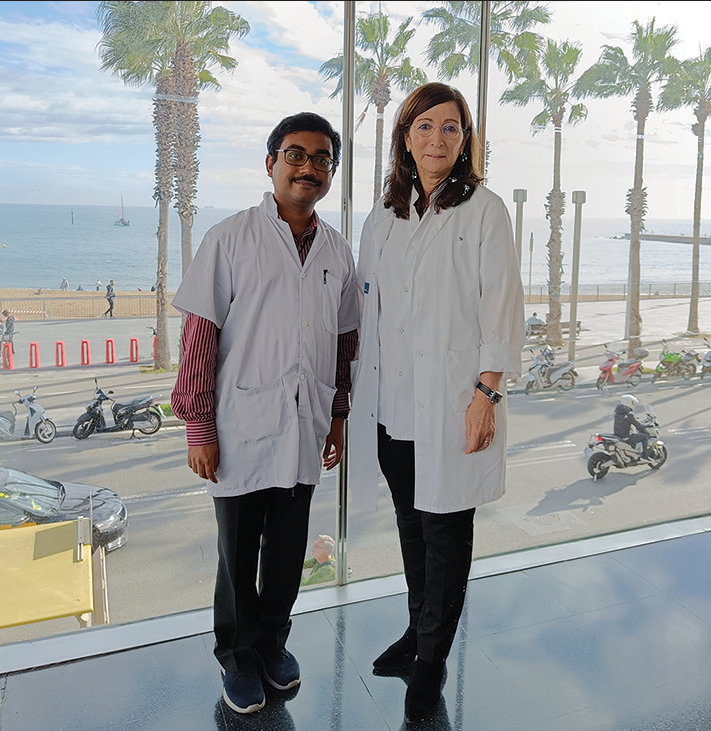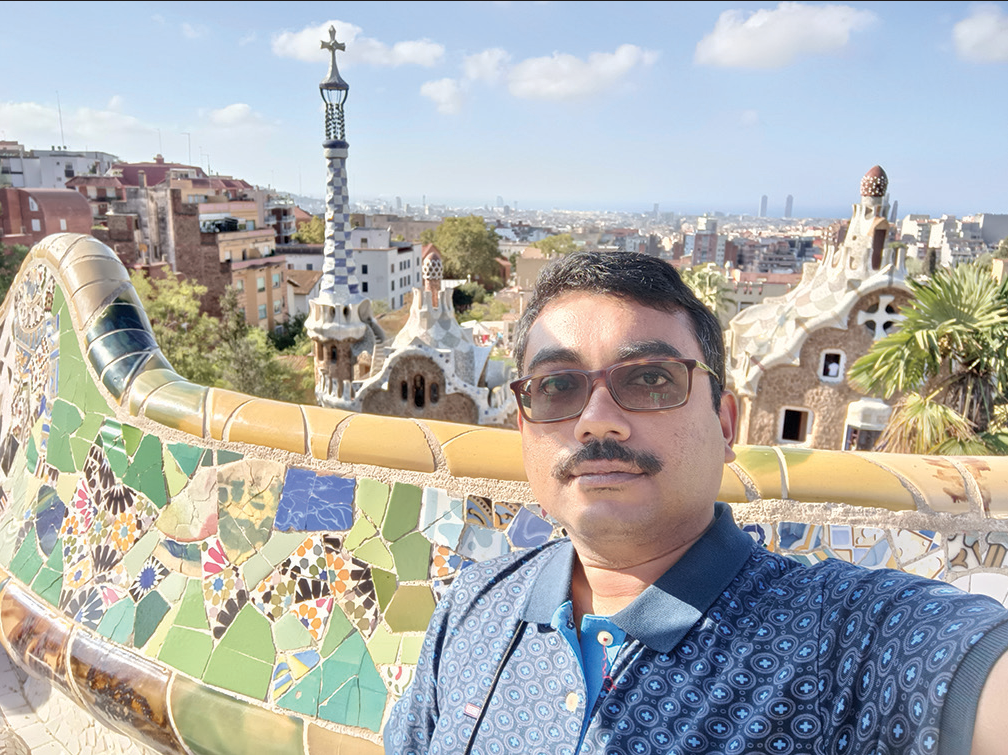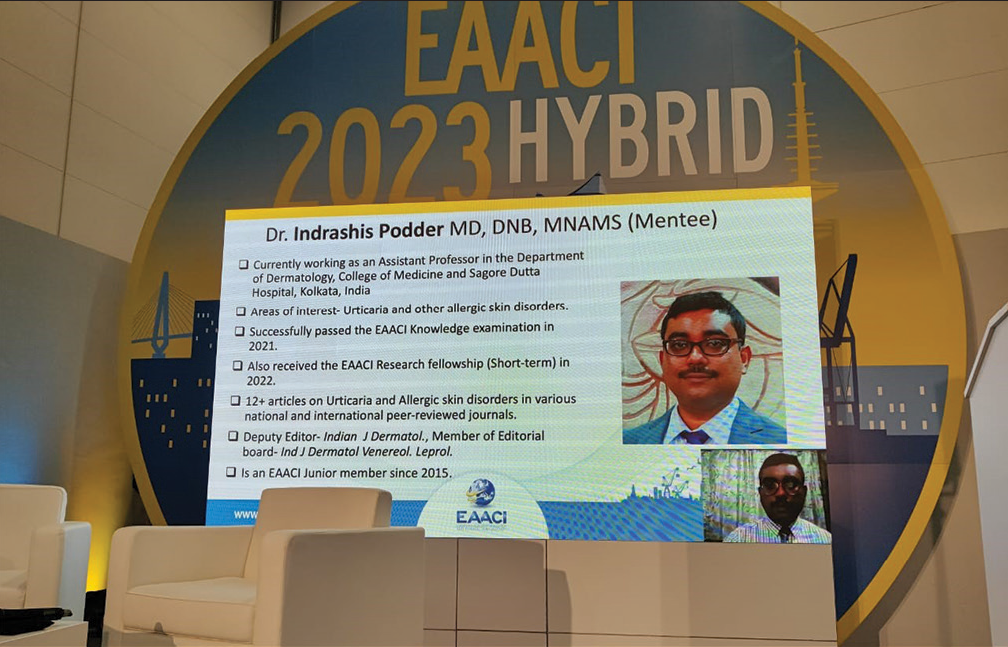Translate this page into:
Fellowship and mentorship opportunities in allergic skin disorders for Indian dermatologists
*Corresponding author: Indrashis Podder, Department of Dermatology, College of Medicine and Sagore Dutta Hospital, Kolkata, West Bengal, India. ipodder88@gmail.com
-
Received: ,
Accepted: ,
How to cite this article: Podder I. Fellowship and mentorship opportunities in allergic skin disorders for Indian dermatologists. Indian J Skin Allergy 2023;2:92-6.
Dear Editor,
Dermatology, like all other medical specialties, is constantly evolving and getting updated. Allergic skin disorders constitute an important problem in today’s world, but they often remain neglected and are considered somewhat trivial compared to other skin ailments such as psoriasis or melanoma. The term “allergy” indicates an immunologically mediated exaggerated hypersensitivity reaction to harmless environmental antigens, called “allergens.”[1] These disorders may be respiratory or cutaneous, with frequent overlapping at later stages. Such patients often have an “atopic” background, referring to a hereditary predisposition to overproduce immunoglobulin E antibodies. Atopic dermatitis, contact dermatitis, and urticaria are the most frequently encountered allergic skin disorders.[2]
A recent global burden of disease analysis has reported rising prevalence and incidence of atopic dermatitis over the past 20 years, especially in young children residing in high-income countries, and highlighted its potential for causing significant morbidity.[3] A similar rising trend of allergic disorders has also been reported by Pawankar[4] over the past 2–3 decades, in children hailing from low-and middle-income countries. Although this trend is more conspicuous for respiratory allergies such as asthma and allergic rhinitis, cutaneous allergic disorders such as atopic dermatitis, contact dermatitis, and urticaria have also undergone a considerable rise. Several contributory factors have been implicated in this spurt of allergic disorders such as increased rates of cesarean delivery, reduced breastfeeding, indiscriminate and early use of antibiotics, a westernized diet and resultant obesity, and changes in indoor and outdoor lifestyle and activity patterns.[5]
Although the rise in allergic disorders, including allergic skin disorders is a global phenomenon, there are considerable geographic variations. The diagnostic and treatment facilities for these conditions are also not uniform, due to varying economic scenarios and medical insurance policies around the world. Hence, it is imperative to develop collaborating and networking opportunities for dermatologists around the world, to apprise them about the real-world global scenario. Such opportunities are usually provided by various fellowship and mentorship programs, which allow the selected candidates to travel to different countries and be trained by the supervisors or mentors of their choice, who are global experts in this domain of medicine. It would enable the sharing of knowledge with international dermatologists, help us learn new techniques, help us develop a fresh perspective, and broaden our knowledge in the subject. In addition, such programs promote cross-cultural exchange between fellows and broaden their mindset.
There are various fellowship and mentorship opportunities offered by international/national dermatology/allergy societies in this regard. In addition, there are several travel grant opportunities, which facilitate the travel of selected candidates to conferences of their choice and interact with peers. There is a dearth of information about such opportunities regarding allergic skin disorders, and this article aims to dissipate such information to help our readers. However, this information is not exhaustive and is based on the author’s experiences and knowledge.
FELLOWSHIP/MENTORSHIP OPPORTUNITIES AND TRAVEL GRANTS IN ALLERGIC SKIN DISORDERS
As with other specialties, there are several fellowship/ mentorship opportunities for dermatologists too. However, most of them cater to inflammatory dermatoses such as psoriasis or immunobullous diseases or skin malignancies such as melanoma. Another set of such on-site opportunities is available for procedural and surgical dermatology. In comparison, few fellowships exist for allergic skin disorders in particular, although they have been showing a rising trend over the years. Instead, there are fellowships for allergic diseases/allergology as a whole, which comprise both respiratory, for example, asthma and allergic rhinitis, cutaneous allergies, food allergy, drug allergy, and so on. Such fellowships are highly competitive, as all physicians are eligible to apply who deal with such patients including internists, pulmonologists, otorhinolaryngologists, ophthalmologists, pediatricians, and dermatologists. It is fairly difficult to be selected for such broad range fellowships as centers offering fellowships on respiratory allergic diseases such as asthma far outnumber those offering on allergic skin disorders, due to the vast differences in prevalence. However, in the author’s opinion, such fellowships are most suitable for those interested in allergic skin disorders, and the offering centers should be searched thoroughly. [Table 1] lists some of the important fellowships in this regard and their relevant details. Some travel grants are also mentioned, and some general dermatology fellowships, in which the applicant may select an allergic skin disorder such as atopic dermatitis, contact dermatitis, or urticaria.
| Name of fellowship/mentorship program | Agency to apply | Award details | Application procedure/details | Website | |
|---|---|---|---|---|---|
| EAACI research fellowship program | EAACI | • Clinical fellowship-3 months, EUR 4000 • Research Fellowship-Short term (3 months)#-EUR 5000; Long term (6 months)-EUR 12,500 |
• The applicant has to be an EAACI Junior member (<35 years) [free of charge] • A supervisor (EAACI member) has to be selected by the candidate, and a project proposal needs to be prepared, which needs to be submitted for review and selection • Documents needed-CV of the applicant, project proposal, host institute (European) acceptance and home institute (India) release forms, letter of motivation • Highly competitive, applicants can be from any discipline interacting with allergic disorders-pulmonologists, ENT, Pediatricians, dermatologists, ophthalmologists, internal medicine • Timeline-The past date of application is usually 31 October, for the subsequent year, check website regularly |
www.eaaci.org | |
| EAACI Mentorship program# | EAACI | • Virtual mentorship program, usually for 2 years | • The applicant has to be an EAACI Junior member (<35 years).[free of charge] • There is a “call for mentees,” when 3 mentors have to be selected from a list, in order of preference • Documents needed-CV of the applicant, letter of motivation, online application via website • 12 mentees are selected from around the world every year, and paired with their mentor, as per availability and choice of mentee • Timeline-variable, regular checking of website suggested |
www.eaaci.org | |
| ACDS Mentoring award | ACDS | • Maximum funding-3,000 USD per applicant | • Either the mentor or the applicant must be a member of ACDS • Maximum age limit-young dermatologist, up to 5 years of completing residency in dermatology • Candidate must select a suitablementor, and prepare a project on “contact dermatitis” and submit it for review • Documents needed-CV of the applicant, statement of purpose including the proposal, letter of support from mentor, proposed budget with break-up • Timeline-The applications are reviewed every 6 months. The deadline to apply for a mentoring award is 11:59pm CST on April 15 and October 15 of each year |
https://www.contactderm.org | |
| Maibach travel award | ACDS | • $1,000.00 stipend to attend the ACDS annual meeting. | • Applicant must be member of the ACDS • Must be the presenting author of an oral/ poster in the annual meeting, focus area- contact dermatitis • Application must be made during abstract submission, through online platform • Candidates should be at the equivalent level of U.S. residents, fellows, or post-doctoral instructors to be considered for this award. This status must be documented by a letter from the applicant’s program director or supervisor |
https://www.contactderm.org | |
| International Fellows-in-Training Travel Scholarship | AAAAI | • A grant of 2000 USD to attend the AAAAI annual meeting | • Grants are awarded to postdoctoral applicants in training in allergy/immunology who are within 7 years at the time of application of their latest doctoral degree and who are outside the U.S. and Canada • The applicant is an International FIT Member of the AAAAI or has a completed membership application on file at the time of application • Priority will be given to applicants who have not received a scholarship in the past • Applicant must be listed as an author for an abstract accepted for presentation at the annual meeting • Online application with CV, a summary of clinical/laboratory research and a copy of the submitted abstract |
https://www.aaaai.org/ | |
| ISPD Mentorship program* | ISPD | • Virtual mentorship program for 12 months | • Applicant must be member of ISPD (free of charge) • The mentor and mentee should meet virtually at least once every 2 months • A list of mentors is provided, applicant has to choose 3 best mentors based on area of expertise • Online application with CV, letter of motivation • Five mentees selected every year |
https://www.ispedderm.com/ispd-mentorship-program | |
| ISD Mentorship program*# | ISD | • Maximum 3 months, stipend of 1000 USD/month | • Applicant must be member of ISD • Online application • Applicant has to select 3 mentors in order of preference • Documents needed-Letter of recommendation from IADVL, applicant’s CV |
www.intsocderm.org | |
| IADVL Guruderma Mentorship program* | IADVL | • Virtual mentorship for 2 months, INR 10,000 and certificate at end of fellowship | • Applicant must be a life member of IADVL, and completed MD/DNB/Diploma in Dermatology • Online application • Applicants must choose 3 mentors according to order of preference from the IADVL list of mentors, each mentor will oversee 2 mentors • Documents needed-Applicant CV, letter of motivation, maximum age of mentee-40 years • Timeline- Variable, check website regularly |
www.iadvl.org | |
| IADVL Observership (there is an observership on urticaria) | IADVL | • PLM/LM < 35years-4 weeks, stipend INR 10,000 • LM > 35 years- 2 weeks (no stipend) |
• Applicants should have obtained their MD or diploma or DNB in Dermatology (and not still pursuing their studies) • They should not be working in the same institution or same city • They should not have availed the observership earlier • Online application, CV, necessary education proofs • Applications usually open around November every year, check website regularly |
www.iadvl.org | |
AUTHOR EXPERIENCE
The author was selected for the prestigious European Academy of Allergy and Clinical Immunology (EAACI) Research Fellowship (Short term) in 2022, and he spent 3 months at Barcelona, Spain in Hospital del Mar IMIM, a tertiary care center. His topic of fellowship was “Role of gut microbiome in chronic spontaneous urticaria” (CSU), and his guide was Prof. Ana Maria Gimenez-Arnau, a leading urticaria expert in the world [Figure 1]. He learned the finer nuances and recent developments in this field including inducible urticarias such as cold urticaria and cholinergic urticaria, and their various diagnostic provocation tests, and more advanced diagnostic tests in CSU, such as basophil activation tests and FceR1 receptor assays. He also attended the general dermatology clinic to see a variety of regional clinical cases, and several dermatology procedures. He saw a lot of skin malignancies such as basal cell carcinoma, melanoma and squamous cell carcinoma, inflammatory disorders such as psoriasis, atopic dermatitis, and pigmentary disorders like freckles. In comparison to our country, infective diseases such as bacterial and fungal infections were much less frequent. Melanoma is extremely rare in our country, but it is very common in Western countries and a cause of serious concern due to its malignant potential. Another interesting aspect was the widespread use of biologics for various disorders, for example, omalizumab for CSU, and if needed they could be continued lifelong, as it is covered in the state health insurance. In contrast, the use of biologics is much limited in our country due to the absence of any state health insurance and their prohibitive cost. He also attended other allergy clinics such as atopic dermatitis and contact dermatitis, and updated himself with the latest knowledge and information concerning these disorders In addition to academic work, the author was extremely fortunate to experience the incredible city of Barcelona, memories to treasure forever. He visited several museums and other nearby cities and places to learn about the wonderful and interesting culture and history of Catalunya and Spain [Figure 2].

- Author with his research guide (Ana Maria Gimenez Arnau) at Hospital del Mar, Barcelona, Spain.

- Author at park Guell, Barcelona, Spain.
The accommodation and fooding had to be taken care of by the author himself, as EAACI provided a corpus amount. There are lots of Indian students in such European cities, and they often sublet their accommodation for such short-term visiting fellows. Such Indian students may be contacted over social media platforms such as Facebook® and WhatsApp®as there are many such student community groups on such platforms. It is strongly advised not to make any substantial advance payment for such accommodations before reaching the place and checking them out physically. There are reports of lots of fraudulent activities in this regard and one should remain vigilant. Food is mainly Mediterranean cuisine, and the author tried lots of newer and interesting options! However, Indian food is widely available, and usually, provision for cooking is included in the accommodations. However, the author would strongly suggest trying local delicacies and imbibing the local culture to make the most use of such fellowship opportunities. For instance, Paella and Sangria are never to be missed if one travels to Spain!
The author was also selected as one of the ten mentees for the EAACI global mentorship program in 2021. His mentor is Prog. George Konstantinou, Professor of Allergology at the 424 Military Institute at Thessaloniki, Greece. They have authored several manuscripts together, and some more are in the pipeline. Although the mentorship program is officially for 2 years, it is still continuing. The author has learned several nuances of allergic disorders such as food allergy in addition to urticaria. In this regard, the author was invited to the faculty at the recently concluded EAACI Congress in Hamburg, Germany in 2023 to share his mentorship experiences along with his mentor. The author could not attend the congress physically and made a virtual presentation [Figure 3].

- Virtual talk at the EAACI Hybrid Congress, 2023.
CONCLUSION
This article aims to provide an overview of the various fellowship/mentorship opportunities in allergic skin disorders, which may be pursued by an Indian dermatologist. The application details and websites are also provided for the benefit of readers. One must apply for such fellowships, as they are an incredible opportunity to learn the finer details of the subject, meet new people, establish connections, build networks, and explore new places. However, one must be patient, as failure to get selected is common. However, one must not lose hope and keep on applying, the author had to apply for 3 times before finally getting selected. The prerequisite is, of course, making as many publications as possible, and building a robust curriculum vitae (CV). It is important that the applicants choose their field of interest, in this case, allergic disorders, and publish articles in that field to build a CV that shows the applicant’s dedication and interest towards that particular field. I hope that this article will be helpful to know the various opportunities available and also motivate our young readers to apply. Best wishes and all the best!
Declaration of patient consent
Patient’s consent not required as there are no patients in this study.
Conflicts of interest
Dr. Indrashis Podder is on the editorial board of the Journal.
Use of artificial intelligence (AI)-assisted technology for manuscript preparation
The author(s) confirms that there was no use of artificial intelligence (AI)-assisted technology for assisting in the writing or editing of the manuscript and no images were manipulated using AI.
Financial support and sponsorship
Nil.
References
- Allergy and allergic diseases. First of two parts. N Engl J Med. 2001;344:30-7.
- [CrossRef] [PubMed] [Google Scholar]
- Global research trend on allergic skin disorders: A bibliometric analysis from 2001 to 2020. Indian Dermatol Online J. 2023;14:342-6.
- [CrossRef] [PubMed] [Google Scholar]
- Global, regional, and national burden of allergic disorders and their risk factors in 204 countries and territories, from 1990 to 2019: A systematic analysis for the global burden of disease study 2019. Allergy. 2023;78:2232-54.
- [CrossRef] [PubMed] [Google Scholar]
- Allergic diseases and asthma: A global public health concern and a call to action. World Allergy Organ J. 2014;7:12.
- [CrossRef] [PubMed] [Google Scholar]
- Early life microbial exposures and allergy risks: Opportunities for prevention. Nat Rev Immunol. 2021;21:177-91.
- [CrossRef] [PubMed] [Google Scholar]





